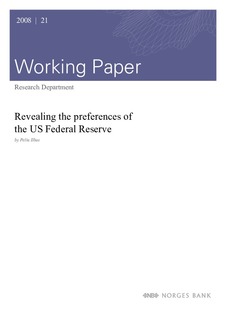| dc.contributor.author | Ilbas, Pelin | |
| dc.date.accessioned | 2018-05-09T10:59:58Z | |
| dc.date.available | 2018-05-09T10:59:58Z | |
| dc.date.issued | 2008 | |
| dc.identifier.isbn | 978-82-7553-472-7 | |
| dc.identifier.isbn | 978-82-7553-473-4 | |
| dc.identifier.issn | 0801-2504 | |
| dc.identifier.issn | 1502-8143 | |
| dc.identifier.uri | http://hdl.handle.net/11250/2497764 | |
| dc.description.abstract | We use Bayesian methods to estimate the preferences of the US Federal Reserve by assuming that monetary policy is performed optimally under commitment since the mid-sixties. For this purpose, we distinguish between three subperiods, i.e. the pre-Volcker, the Volcker-Greenspan and the Greenspan period. The US economy is described by the Smets and Wouters (2007) model. We find that there has been a switch in the monetary policy regime since Volcker, with a focus on output growth instead of the output gap level as a target variable. We further show that both interest rate variability and interest rate smoothing are significant target variables, though less important than the inflation and output growth targets. We find that the "Great Moderation" of output growth is largely explained by the decrease in the volatility of the structural shocks. The Inflation Stabilization, however, is mainly due to the change in monetary policy that took place at the start of Volcker’s mandate. During the Greenspan period, the optimal Taylor rule appears to be equally robust to parameter uncertainty as the unrestricted optimal commitment rule. | nb_NO |
| dc.language.iso | eng | nb_NO |
| dc.publisher | Norges Bank | nb_NO |
| dc.relation.ispartofseries | Working Papers;21/2008 | |
| dc.rights | Attribution-NonCommercial-NoDerivatives 4.0 Internasjonal | * |
| dc.rights.uri | http://creativecommons.org/licenses/by-nc-nd/4.0/deed.no | * |
| dc.subject | JEL: E42 | nb_NO |
| dc.subject | JEL: E52 | nb_NO |
| dc.subject | JEL: E58 | nb_NO |
| dc.subject | JEL: E61 | nb_NO |
| dc.subject | JEL: E65 | nb_NO |
| dc.subject | optimal monetary policy | nb_NO |
| dc.subject | central bank preferences | nb_NO |
| dc.subject | parameter uncertainty | nb_NO |
| dc.title | Revealing the Preferences of the US Federal Reserve | nb_NO |
| dc.type | Working paper | nb_NO |
| dc.description.version | publishedVersion | nb_NO |
| dc.subject.nsi | VDP::Samfunnsvitenskap: 200::Økonomi: 210::Samfunnsøkonomi: 212 | nb_NO |
| dc.source.pagenumber | 52 | nb_NO |

